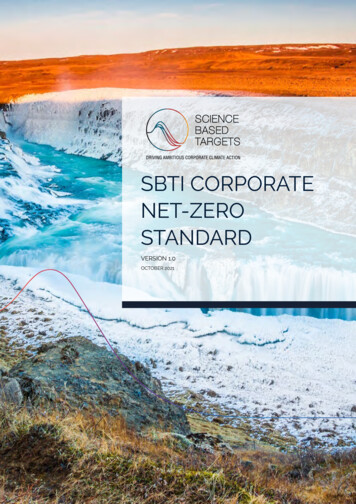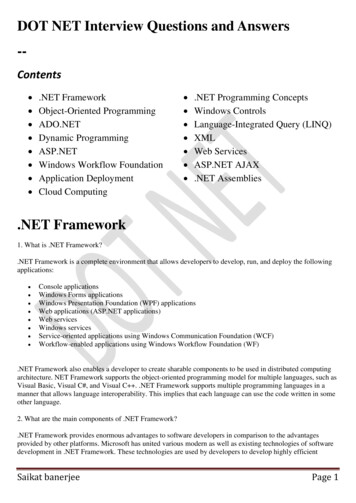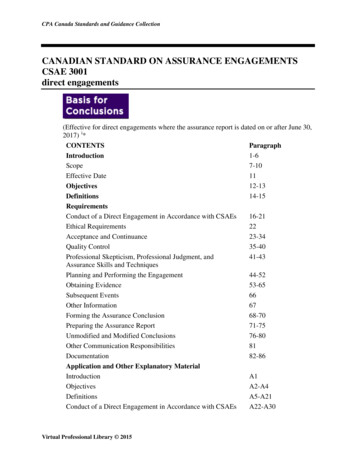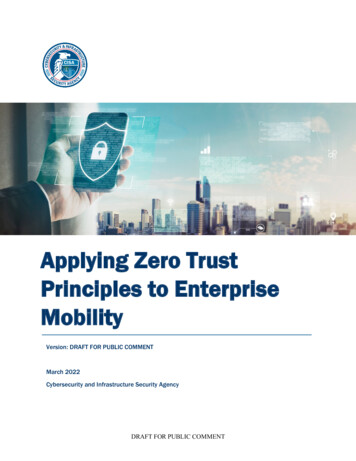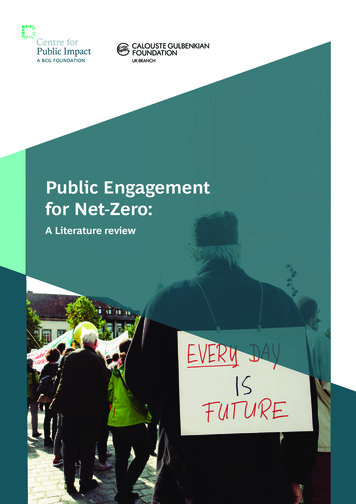
Transcription
Public Engagementfor Net-Zero:A Literature review
About CPI EuropeThe Centre for Public Impact (CPI)is a global not-for-profit, foundedby Boston Consulting Group, with amission to help government and publicsector organisations achieve betteroutcomes for everyone. In the UK,we work with government and publicsector organisations to tackle thecomplex challenges they face, equippingchangemakers with the confidence, toolsand mindsets to listen, learn and adaptin these fast-changing and unpredictabletimes.This Review was co-authored by MartinKing, Chandrima Padmanabhan, and KatieRose at CPI Europe. Thank you to GrahamSmith, Lorraine Whitmarsh, Lucy Stone,Clare Saunders, Brian Doherty and therest of the CPI team for their formativecontributions to this Review. Thank you tothe Calouste Gulbenkian Foundation (UKBranch) for supporting the research andproduction of this Review.This Review is published alongside A CaseStudy Compendium, which shines a lighton eight examples of public engagementfrom across the world. Please visit the CPIproject page to find out more.ContentsForeword4Executive Summary6Introduction: aim and approach8Structure of Review10Section A:Ways of Understanding Public Engagement Around Climate Change:A Challenge of Communication, of Intervention, or of DemocraticCollaboration11I. Public engagement as a challenge of communication12II. Public engagement as a challenge of intervention16III. Public engagement as a challenge of collaboration20Conclusions from the Literature Review24Section B:Further considerations affecting impact of Public EngagementmethodsNeed to embrace complexity26Navigating uncertainty in science communication27Designing for inclusivity and justice28Final Remarks29BibliographyJoin the conversationinfo@centreforpublicimpact.orgFollow us @CPI foundation2530
Public engagement on meaningful behaviour change to achieve Net-Zero 5ForewordIn 2019, on the 150th anniversary of thebirth of our founder Calouste Gulbenkian,the Foundation’s trustees announced theircommitment to prioritise climate change.This included launching the GulbenkianPrize for Humanity, awarding 1 millionannually to recognise contributions to themitigation of and adaptation to climatechange. At the UK Branch, we have beguna complementary programme supportingCitizen Engagement on Climate, seekingto demonstrate what effective publicengagement looks like and create theconditions for its scaling.We have a history of supportingenvironmental work at the UK Branch,including through our Valuing the Oceanprogramme which has illuminated theimportance of effective communicationsin building ambition for environmentalaction. Yet, for some years we wereconcerned that we would not be able tomake a difference in a problem so big andso complex as climate change. However,the growing visibility of climate impactshas reinforced the urgency of the issue. In2019, the Foundation’s trustees decided todivest from our oil and gas holdings whichwere the original source of Calouste’sfortune. In the same year, I was shockedby the terrible flooding at Woolley Bridge,with the risk that an entire village and itsresidents would be subsumed under water,and the catastrophic fires in Australia.It seemed the impacts of our changingclimate were everywhere: cyclones inMozambique, the terrifying hurricanes inthe Caribbean and grave water scarcity inparts of India. The effects are both nearand far. The most vulnerable are thosewhose livelihoods are already insecure andwhose interests we seek to prioritise at theFoundation.investing in this area, it serves as a helpfulrefresher on the vital principles on whichwe should base our approach.This is why it matters and why we feelcompelled to focus on climate change.But what to do about it? We know thatscientific and regulatory solutions are acritical part of the answer. Yet whatevertechnologies we invent or policies wedeploy, there is another critical ingredient:without deep public engagement, we willnot be able to make real, sustainablechange. Our research shows a big gapbetween what is necessary and theresources available for this work. Publicunderstanding and engagement is the soilon which the seeds of government policyor scientific advancement lands. We mustnurture that soil to ensure that when theopportunity comes to act, the seeds landon fertile ground.This year, Glasgow will play host to the 26thConference of the Parties of the UnitedNations Framework for the Convention onClimate Change. Those of us working onclimate change in the UK have a specialresponsibility as a result. We must gathertogether to ensure that the negotiatorsare surrounded by the dual support andchallenge that a vibrant civil societycan offer. We must create a platformfor people doing transformative work totackle climate change all over the world.Most importantly, we must remind theUN negotiating teams that although theyare the ones around the table, the realwork of saving our planet from dangerousclimate change will be done by billions ofus, scattered in towns, cities and villagesaround the world, inland and on thecoast. It is those voices – and the hugeopportunity for change they carry withthem – that must anchor the conversationin Glasgow. So as you read this report, weask you to think about what the climatetransition will mean for people andcommunities, and let us then ask ourselveshow we can best support this.This report – written by the Centrefor Public Impact – offers a powerfulfoundation for that work of bringing thepublic with us in the fight to defend ourclimate. It provides a rich analysis ofpublic engagement models on climatechange, highlighting how communication,collaboration and public engagementaround climate interventions can be mademore effective. Each model has its ownstrengths and limitations, requiringconscious design and facilitation to buildimpactful, sustainable and inclusivepeople-led change. For those of us whoare relatively new to this area of work, thereport offers essential guidance about howto lay good parameters for new projectsgetting started. For those who are alreadyAndrew Barnett OBEDirector, Calouste Gulbenkian Foundation(UK Branch)April 2021
Public engagement on meaningful behaviour change to achieve Net-Zero 7The aim of this Literature Review is to understand effective ways to engage thepublic on meaningful behaviour change that can aid in achieving net-zero emissionsgoals. The Review is a first step to unpacking how public engagement strategies inpractice can be built to be relevant, meaningful and inclusive to the public, while alsoconveying urgency and driving large-scale adoption.Through in-depth desk research and practitioner interviews, the Review draws out threeprominent ways of understanding public engagement around climate change:ExecutiveSummaryI. Public Engagement as a challenge of CommunicationThis explores how the framing of the message, the legitimacy of the messenger, and thevalues and identities of the audience impact communication around climate change, andthereby meaningful engagement.II. Public Engagement as a challenge of InterventionThis draws out how public engagement can effectively incentivise sustainable consumptionand pro-environmental behaviour at an individual, social and systems level.III. Public Engagement as a challenge of CollaborationThis focuses on understanding what makes effective public deliberation on climate policy(for example through mini-publics, citizen assemblies etc.), and impactful citizen-ledgrassroots movements around climate change.Through the three lenses outlined above, this Review provides broad insight on the publicengagement methods that can enable meaningful behaviour change around climate change.It also draws out the gaps in current research - particularly around a) how the complexity ofdecision-making around climate change can be communicated without reductionism, b) howpublic engagement can be made more adaptive to uncertainty and evolving local conditionsand c) how engagement processes can be made more inclusive in order to producelegitimate and just outcomes. The importance of these themes are discussed in the finalsection of this Review, drawing out the need for further research. It highlights the importanceof engaging with these tensions and value-laden decisions in order to ensure the transition toa net-zero world is socially just, sustainable, and impactful.
8 Centre for Public ImpactPublic engagement on meaningful behaviour change to achieve Net-Zero 9Introduction: aim and approachOur aimOur approachAccording to the IPCC SR 1.5 C(2018), global carbon emissionsshould reach net-zero by mid-centuryin order to limit warming to below1.5 C and avoid catastrophic climateimpacts. In response to a growingbody of scientific evidence andmounting public pressure, a numberof governments, including that of theUK, have translated these goals intonational strategy, making tangiblepolicy commitments to move to anet-zero carbon economy.For the purposes of this Review we haveadopted a broad definition of “publicengagement”. Our definition includes anyintervention aimed at communicatingwith or mobilising the public, or changingtheir behaviours, choices or attitudesto positively contribute to reducingemissions. The synthesis report on theAction for Climate Empowerment bythe UNFCCC similarly adopts broaddefinitions of public engagement (FCCC2020).In 2019, the UK made a legallybinding target to achieve net-zeroby 2050. While the UK has reducedemissions by 40% since 1990, thishas been predominantly achievedthrough the decarbonisation ofenergy supply, requiring very littleeffort on the part of the public.Reaching the net-zero target by 2050will require significant behaviouralshifts (as will meeting the legallybinding carbon budgets). This wouldrequire significant investment inpublic engagement, to build mutualacceptability on a way forward.This Review, commissioned by theCalouste Gulbenkian Foundation UKbranch, is a first step in a quest tounderstand effective ways to engagethe public on meaningful behaviourchange that can aid in achievingnet-zero emissions goals. Theresearch aims to underpin furtherstudy on ways by which effectivepublic engagement strategies canbe built to be relevant, meaningfuland inclusive to the public, while alsoconveying urgency and driving largescale adoption.Our methodology followed a 3-stepprocess:First, we conducted an initial abstractreview. We utilised the Web of Sciencedatabase and applied the followingcriteria: Abstract must include the terms:(“public engagement” OR “behaviourchange”) AND (“climate change” OR“zero carbon”) Time-span: 2000-2020The search produced 246 results. Thepapers were published in peer-reviewedjournals providing some assuranceof sufficient quality, relevance andsignificance. We reviewed the abstractsand categorised the papers by descriptivecriteria; how the public are beingengaged, who is leading the engagementand who is being engaged, and on whatissues the public are being engaged.From this we were able to identifythematic clusters of research that sharedan understanding of what the core aimof public engagement around climateaction was, and explore these in greaterdepth. This exploration was guided inan emergent sense, by the number ofresults, rather than pre-existing criteria orpriorities around public engagement. Wealso conducted additional searches usingterms specific to the area to identify themost cited, relevant and recent works forfurther exploration.Second, we reviewed the greyliterature and reports from establishedorganisations and research institutionsin relevant fields. The organisations andresearch institutions targeted for analysiswere Climate Outreach, the Centre forClimate and Social Transformation(CAST), the Climate and Urban SystemsPartnership (CUSP), Futerra, Centrefor Sustainable Energy, the Institutefor Public Policy Research (IPPR), NewEconomics Foundation (NEF), Involve,Grassroots Innovations the Global ActionPlan, the work of Rebecca Willis, theSustainable Consumption Institute atManchester University, and the ResearchGroup on Sustainable Lifestyles andValues (RESOLVE) at Surrey University.These organisations were selected onthe basis of various criteria, primarilythrough a form of snowball samplingwhich noted that they were frequentlyreferenced by research and practitioners.Further, these organisations representeddiverse perspectives and viewpoints onthe subject, and met considerations ofaccess and relevance in the context of theReview.Third, we interviewed practitioners andacademics with established experiencein the area of public engagement andclimate change. The purpose of thesesteps was to ensure our account of theliterature was informed by a diverse rangeof sources, perspectives and viewpoints.Our interviewees included individualsworking at Involve, CAST and IPPR.Illustrating our tureReviewInterviewsScope and LimitationsBy nature, literature reviews are proneto degrees of imprecision, particularlywhere the area is as wide as publicengagement in the context of climatechange. Different approaches to reviewswill always be prone to exaggeratingaspects of a phenomenon andoccluding others. Given these inevitableconstraints, we have sought to providea review drawing on credible sources,providing a balanced account of theavailable information and ensuring theyare relevant to the central issue.The papers used in the abstract reviewwere published in peer reviewedjournals and therefore providesome assurance that independentprofessionals in the relevant fieldregarded the research as sufficient inquality, relevance and significance. Thiswork was supplemented by deep divesinto key texts and reviews (frequentlycited papers pertinent to the review),an exploration of grey literature andthe work of prominent organisations(as outlined above), and interviewswith experts in the field. This wasnecessary in order to develop a deeperunderstanding of the theory and practiceof public engagement on climatechange given the limited informationavailable in abstracts. However thispractice introduces a trade-off betweendepth and balance as we are relyingon a smaller number of sources togather richer information. Althoughthese sources were well-establishedand credible, we must recognise thatthey only represent a sample of thepotential research and perspectives.In order to ensure transparency, wehave indicated sources, identifiedtheoretical perspectives underpinningthe approaches, and sought to offerdescriptions of research in their ownterms as well as recording criticismsfeatured in the wider literature.We have limited our scope to researchfrom high-income developed countries(and more specifically countries referredto as Annex II countries by the UNFCCC).It is enshrined in the UN ClimateConvention (1992) and re-establishedthrough the Paris Agreement that thesecountries need to lead the charge onemissions-reduction. In addition, orperhaps due to this, the understandingof and responses to climate changemitigation objectives such as Net-Zeroare better researched and documentedin highly industrialised economies ofAnnex II countries. Given the geographicscope, the sectors that were researchedare those seen as contributing highlyto consumption emissions in thoseeconomies including transport, food anddiet, and domestic energy (Carmichael2019). This review acknowledges thisfocus as a limitation, as the ensuingdiscussion misses out on considerationsand perspectives relevant to the contextof developing economies, and thesystemic impacts of climate-relateddecision-making on those geographies.As these considerations form an integralpart of meeting a global net-zero goal,further research on public engagementpractices in developing country contextsis imperative.
10 Centre for Public ImpactStructure of ReviewSection ASection BSection A illustrates the prominent ways ofunderstanding public engagement in theclimate space from the main themes thatemerge from the literature. These themeshave been organised into three categories:Section B attempts to draw togetherconclusions from the literature – asfar as this is possible. This section alsohighlights further considerations key tounderstanding the climate challengeas one that engages with complexity,uncertainty and deep-seated issues ofjustice and inclusion, drawing out whatthat might mean for public engagement,and new avenues of research. public engagement as a challenge ofcommunication public engagement as a challenge ofintervention public engagement as a challenge ofcollaborationThis section explores each of these threecategories, highlighting the prominentinsights and debates on how each methodand/or process seeks to achieve behaviourchange around climate change. It alsoaims to provide some insight into thebenefits and limitations of each of theseways of framing and understanding publicengagement.Section A:Ways of Understanding PublicEngagement Around Climate Change:A Challenge of Communication,of Intervention, or of DemocraticCollaboration
12 Centre for Public ImpactPublic engagement on meaningful behaviour change to achieve Net-Zero 13I. Public engagement as a challenge ofcommunicationOne understanding of public engagement from the literature is as a challenge of communication.Specifically, it explores how factors relating to the source of information, the message and the audienceimpact the effectiveness of communication. The link here between public engagement and behaviourchange is through the development of effective communication strategies that speak to peoples’ valuesand identities, encouraging the public to care about climate change and generating a mandate for action(Moser 2010, Whitmarsh 2013, Carvalho 2017, Schafer 2012, Corner et al 2014).Insights and debatesaround communicationas a way to understandpublic engagementThis research emerges from studies incommunication and persuasion aroundclimate change. It draws on psychologicalmodels, notably the elaboration likelihoodmodel (Lazard 2015, Myrick and Comfort2020) and the appraisal theory of emotions(Lazard 2015, Myrick and Comfort 2020)to explore the role of values, emotions,and context in communication on1The messengerIt is important for the source ofinformation to be trusted and credible.The extent to which an audience truststhe source of information will dependin part on perceptions of authority andthe messenger’s expertise. However,the research suggests these judgementsare highly contingent upon widersocial and political conditions and theextent to which the audience matchtheir own values and identity onto themessenger (Donner 2017). In this sense,the question audiences might ask ofthe source relates more to whetherthis person is like them and sharestheir values and outlook, rather thantheir qualifications, in determiningwhether they are to be trusted (Cornerclimate change. There are a number ofareas of consensus in literature. Thereis acceptance that the deficit model isnot sufficient. This means that simplyproviding people with informationabout climate change is not sufficientto encourage people to care about theclimate or support action on climatechange (Maibach et al., 2008; Myers,2003; Pitrelli, Manzoli, & Montolli, 2006 inLazzard 2015). There is agreement thatin order to communicate effectively youneed to reframe the debate and providenarratives that resonate with the identitiesand values of your audience. These needet al 2014, Corner n.d). Research hasfocused on the impact of polarisationand the domination of particularsegments of society in taking ownershipof the issue which has resulted inscepticism and disengagement forothers. Specifically, climate changeis commonly perceived as an issueowned by left wing, progressive,middle-class liberals and activists. Thisperception is exacerbated by varioustrends in politics and marketing (e.g.‘green marketing’ is targeted at thisaudience). As such a conversationhas emerged around climate changeconducted by and for a small sectionof the population. Research suggeststhe need for messengers to come fromgroups currently marginalised by thismessaging and marginalised moregenerally by the political process. For2The messageIn relation to engaging the public ingeneral on climate change, points ofconsideration on ‘messaging’ include: to encourage the audience to see climatechange as an important, tangible threatthat they should take ownership of andseek to address.There are debates within the literatureabout how best to do this, with differentstrands of research focusing ondifferent avenues and possibilities forbetter engagement on climate change.We can consider these in relation tothree interrelated elements of thecommunication process:1. the messenger2. the message3. the audience.example, Corner (n.d) has called for“heroes” and champions on the centreright to lift climate change out of its leftwing niche. Research also highlightedthe need for greater attention to be paidto the marginalisation of certain groupsand communities in conversations onclimate change. Pearson et al (2017)draw attention to the need for greaterdiversity with respect to class, race andgender in climate communications. Theresearch has also focused on the way“elite” messengers are perceived (e.gcelebrities (Leas et al 2016), religiousauthorities (Myrick and Comfort 2020))with evidence suggesting it can be adouble edged sword (Whitmarsh 2013).While it may positively impact the profileof an issue (Whitmarsh 2013), it oftenrisks negative reactions and resistance(see Myrick and Comfort 2020).such as anger, and self-relatedsuch as guilt or shame). Researchexplores the emotional impact ofdifferent messaging on climatechange and the relationshipbetween affective reaction andrisk appraisal (see Bohm 2003).Messaging on climate changecan also be linked to positiveemotional responses includinghope, and efficacy. There is generalconsensus around the need tocouple negative and positivemessages. For example, fear mightgrab people’s attention but canlead to despair, therefore it can behelpfully paired with messages ofconstructive action (efficacy) andmore positive messaging around cobenefits. Crucial to these messagesis ensuring the audience findsthe messaging around both riskand hope credible and relatable.This will be different for differentaudiences, and depends on factorssuch as the source of informationand how successfully framing andnarrative matches the values andidentity of the audience. Framing and narrative: Aprimary focus of the researchinvolves understanding the mosteffective framing and narrativesfor climate change messaging.This refers to the broad frames ofthought through which the issueis understood and the valuesappealed to (Corner et al 2014). Forexample we could frame climatechange as a war, as a race, or aproblem. We could appeal to valuesof avoiding waste, preservation(e.g biodiversity), or preparedness.The most effective framing andnarrative will depend greatly onthe values and identities of theaudience, and much of the researchis focused on testing how differentlanguage, framing and narrativesresonates with different audiences(Corner et al 2014, Moser 2010,Saltmarshe n.d).Drawing on Emotion: Thereis a large body of literatureon the emotional reactions tomessaging on climate change,including emotional reactions toclimate change risks and positivemessaging around hope, efficacyand potential co-benefits. Bohm(2003) provides an influentialaccount of different emotionalresponses to environmental risks,distinguishing consequence-basedemotion (for example, prospectiveemotions such as fear, despair,worry, and retrospective emotionssuch as sadness, sympathy),and ethical-based emotions (forexample, other-related emotions Connecting climate change tohuman-centred co-benefits:Research in this area has exploredthe potential of linking climatechange to more tangible issuesand highlighting co-benefits. Forexample, linking action on climatechange to better jobs, wellbeing,biodiversity and health. There hasbeen significant interest in drawingout the links between climatechange and better health outcomes(e.g. in relation to diet, air pollution).As highlighted above, crucial tothe efficacy of this message isthat the source is trusted (e.g.in this case parental groups andhealth professionals were foundto be more trusted sources for thismessaging). Furthermore the publicmust find the link credible andrelatable (e.g. they feel vulnerableto the health risk). For example thelink between a low carbon diet anda healthier diet varies in acceptanceamongst different audiences(the young find it more crediblethan older generations). Similarlyresearch around air pollutionfound that appealing to the claimthat air pollution causes cancerwas met with scepticism (evokingassociations with the thought that“everything causes cancer”), whilemessages that emphasised linkswith asthma were more effective. Visual imagery: The research hasexplored the significance of imageryassociated with messaging aroundclimate change. It has long beenrecognised that images overpowerwords in persuasive messages(Griffin 2008, Messaris 1994 inLazzard 2015). This area of researchexplores variables of differenttypes of imagery in encouragingthe audience to care about climatechange and overcome distancing. Forexample it finds that it is importantto show real people not staged photoops, local but serious examples ofimpact, and to be very careful withimagery of protestors (which cancause resistance amongst peoplewho don’t identify with these groups)(Corner et al 2015). We should notethere are ethical considerations inrelation to telling stories or sharingimages of particular groups, andpractitioners need to ensure that theimages they show of people do notnegatively impact or result in anyharm to them.
14 Centre for Public ImpactPublic engagement on meaningful behaviour change to achieve Net-Zero 15Evaluation and limitations3This approach draws on an evidencebase derived primarily from focus groupsand surveys which test responsivenessto different types of messages. Althoughthe Review did not find major schismsin the literature on how to understandcommunication, there was variation in howstudies operationalise different variablesand measure impact. Researchers highlightthat the majority of evidence is drawn fromstudies in the US and therefore groundedin a particular cultural context limitinggeneralisability of findings. In addition,there are challenges with measuring long-The audienceWe have observed, throughout theresearch, the significance of theaudience in understanding how climatechange messaging is processed. Theresearch considers a range of variablesin exploring effective communication,including general considerations ofliteracy and numeracy as well as thetiming of communication (Bostromet al 2013). A significant strand ofthe research involves segmentingthe audience by demographic andattitudinal criteria to understanddifferent responses and to developbetter strategies for communicatingwith these groups (Bostrom et al 2013,Hine et al 2014). There has been aparticular focus on political values,ideological world-views and culturalmindsets, but also increasing interestin non-partisan social factors includingracial and ethnic identities, social classand gender. The research suggeststhat these factors interact, and thatbeliefs and risk perceptions aroundclimate change are more polarisedamongst advantaged groups thandisadvantaged groups (Pearson etal 2017). There has been particularresearch interest in addressing thescepticism prominent amongst centreright audiences (Corner n.d), and theidentification of conservative whitemen (Ballew et al 2020) and centreright evangelical groups as notablyresistant (this is arguably a reflectionof the dominance of US research inthe cultural setting of this research).Pearson et al (2017) describes howthere has been relatively less attentionto those groups for whom the issue ofclimate change is less politically chargedsuch as racial and ethnic minoritiesand members of socioeconomicallydisadvantaged groups. Pearson et al(2017) argues there is a research gaparound these audiences, as these groupsare currently poorly served by climatechange messaging. Additional researchhas considered engaging faith groups(Marshal et al 2016), different nationalidentities (Marshal 2014), young people(Dodson and Papoutsaki 2017), and lowincome groups (Pearson et al 2018).Research develops evidence around howto frame information and what narrativeor stories to tell to resonate with thevalues and identity of different groups.There is also a focus on developingprofiles of different languages, framingsand narrative techniques for engagingspecific groups. For example, talkingabout “creation” when engaging faithgroups on climate change was foundto resonate well with Muslim, Jewishand Christian faith groups, but less wellwith Hindu and Buddhist faith groups(Marshal et al 2016). The centre rightare easier to engage on climate changeby framing the conversation aroundvalues such as responsibility, avoidingwaste, protecting the land, rather thanon issues of justice (e.g. supporting thevulnerable, addressing inequalities).Finally, there is also the issue oftargeting. The research warns againstexacerbating polarisation withmessaging that might engage someaudiences while alienating others(Pearson and Schuldt 2015, Whitmarshand Corner 2017). Therefore theresearch in this area considers notonly what messaging is most effectivewith an audience, but also whatmessaging is least polarising. Forexample, a study by Whitmarsh andCorner (2017) found framing around“avoiding waste” resonated well acrossall groups in contrast to climate justice(e.g the view that climate impacts themost vulnerable first, therefore it isthe responsibility of those in greaterpositions of wealth and power toaddress it),which works well with leftaudiences, or patriotism (e.g preservingthe nations’ heritage/countryside)which works b
Executive Summary 6 Introduction: aim and approach 8 Structure of Review 10 Section A: Ways of Understanding Public Engagement Around Climate Change: A Challenge of Communication, of Intervention, or of Democratic Collaboration 11 I. Public engagement as a challenge of communication 12 II. Public engagement as a challenge of intervention 16 III.


